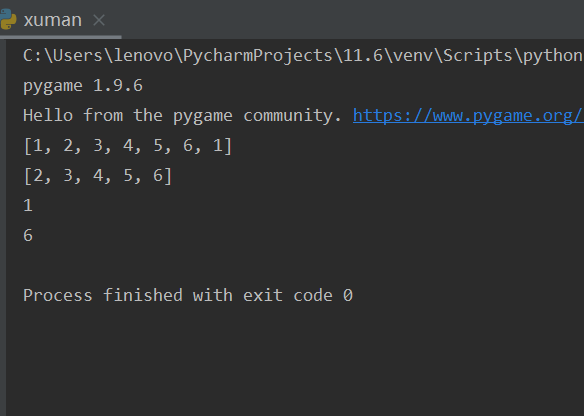1,选择排序
#选择排序 def select_sort(arr): for start in range(len(arr)-1): max_index=start for i in range(start,len(arr)): if arr[max_index]<arr[i]: max_index=i arr[max_index],arr[start]=arr[start],arr[max_index] arr=[1,2,3,4,6,1,32,9] select_sort(arr) print(arr)
2,回文
#回文 from collections import deque def hw(s): dq=deque(s) while len(dq)>1: if dq.popleft()!=dq.pop(): return False return True s="radar" print(hw(s))
3,表达式的前缀
#前缀 def mid2prefix(exp): exp=exp[::-1] OPRS='()+-*/' ans="" stack=[] for e in exp: if e in OPRS: if not stack or e==')': stack.append(e) elif e=='(': #去掉左右括号 while stack[-1]!=')': ans=ans+stack.pop() stack.pop() elif OPRS.index(e)>=OPRS.index(stack[-1])//2: #+-或*/优先级相等 stack.append(e) else: while stack and OPRS.index(e)//2<OPRS.index(stack[-1])//2: ans=ans+stack.pop() stack.append(e) else: ans=ans+e while stack: ans=ans+stack.pop() return ans[::-1] s='4+(2+3)*2' print(mid2prefix(s))
4,后缀表达式
#后缀 def mid2prefix(exp): OPRS='()+-*/' ans="" stack=[] for e in exp: if e in OPRS: if not stack or e=='(': stack.append(e) elif e==')': #去掉左右括号 while stack[-1]!='(': ans=ans+stack.pop() stack.pop() elif OPRS.index(e)>=OPRS.index(stack[-1])//2: #+-或*/优先级相等 stack.append(e) else: while stack and OPRS.index(e)//2<OPRS.index(stack[-1])//2: ans=ans+stack.pop() stack.append(e) else: ans=ans+e while stack: ans=ans+stack.pop() return ans s='4+2+3*2' print(mid2prefix(s))
5,前缀表达式的还原计算
#前缀表达式的还原计算 def caic_prefix(exp): stack=[] exp=exp[::-1] ans=0 for e in exp: if e not in '+-*/': stack.append(e) else: ans=eval(stack.pop()+e+stack.pop()) stack.append(str(ans)) return stack[-1] return eval(stack[-1]) s='/*++32156' print(caic_prefix(s))
6,哈希表
#集合与哈希表的使用 #集合 def find_repeat(s): s1=set(s) return len(s)!=len(s1) s='assd' print(find_repeat(s)) #哈希表 def find_repeat_dict(s): ht={} for c in s: if c in ht: #有重复的就放回True ht[c]=ht[c]+1 return True else: ht[c]=1 return False s='aabbcd' print(find_repeat_dict(s))
7,找出相反数的对数
#相反数 def count_matches(s): ht={} for c in s: c=abs(c) if c in ht: ht[c]=ht[c]+1 else: ht[c]=1 return len([x for x in ht.values() if x == 2]) s='1,2,3,-1,-2,-3' print(count_matches(s))
8,列表中的2数之和等于给定的值
#两数之和 def sum(arr,target): ht=dict() for i,e in enumerate(arr): #i表示遍历下标,e表示遍历值 if target-e in ht: return (i,ht[target-e]) else: ht[e]=i s=[2,7,11,15] b=9 print(sum(s,b))
9,找出列表中两数之和等于和给定数的两数的下标
#找出列表中两数之和等于和给定数的两数的下标 def sum(arr,target): ht=dict() #创建一个空字典 for i,e in enumerate(arr): #i表示遍历下标,e表示遍历值,enumerate表示一边遍历一边转换为字典 if target-e in ht: return (i,ht[target-e]) else: ht[e]=i s=[2,7,11,15] b=9 print(sum(s,b))
10,优先队列,找出第k小的数
#优先队列,找出第K小的数 from queue import PriorityQueue def get_k_min(arr,k): pq=PriorityQueue() for e in arr: pq.put(e) while k>0: elem=pq.get() k=k-1 return elem #print(pq.queue) #print(pq.get())#输出最小的一个数,按照最小的出队 arr=[12,17,11,15] print(get_k_min(arr,3))
11,利用哈希表查找最小字符串
#利用哈希表查找最小字符串 def longest_substr_1(s): if not s: return 0 start=0 end=0 ht={s[0]:0} #haxibiao max_sub=1 for i in range(1, len(s)): # range方位为左闭右开 if s[i] in ht: start = max(ht[s[i]] + 1, start) ht[s[i]] = i else: ht[s[i]] = i end = i max_sub = max(max_sub, end - start + 1) return max_sub print(longest_substr_1('abcabcdab'))
12,利用列表查找最小字符串
#利用列表查找最小字符串 from queue import Queue def longest_substr_2(s): q=Queue() max_substr=0 for e in s: while e in q: q.get() q.put(e) max_substr=max(max_substr,len(q)) return max_substr print(longest_substr_2('abcabcdab'))
13
#请选择一个合适的数据结构MyData,尽可能高效的实现元素的插入,删除,按值查找和按序号查找(假设元素值各有不相同) #*提示:可以使用列表和字典来组合实现 import pygame class MyData: def change(a): #以元组的方式输出序列,并且转换为列表 b=list(a) return b #返回列表 def Insert(a,B): #插入新元素 m=MyData.change(a) b=m.append(B) b=m print(b) def delete(a,B): #删除新元素 m=MyData.change(a) b=m.remove(B) b=m print(b) def value_off(a,B): #按值查找 m=MyData.change(a) q=-1 for i in m: q=q+1 if B==i: print(q) def index_off(a,B): #按照序号查找新元素 m=MyData.change(a) print(m[B]) if __name__ == '__main__': a=1,2,3,4,5,6 MyData.Insert(a, 1) MyData.delete(a, 1) MyData.value_off(a, 2) MyData.index_off(a, 5)

























 1万+
1万+

 被折叠的 条评论
为什么被折叠?
被折叠的 条评论
为什么被折叠?








